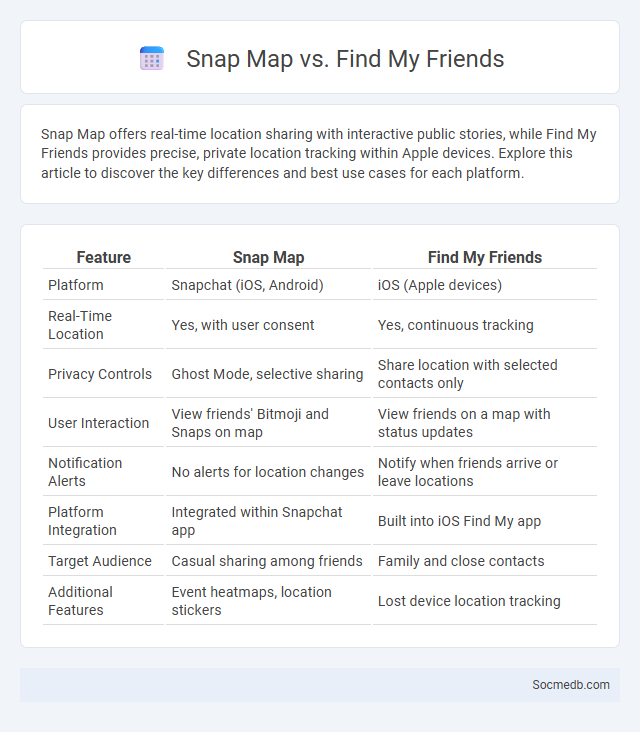
Photo illustration: Snap Map vs Find My Friends
Snap Map offers real-time location sharing with interactive public stories, while Find My Friends provides precise, private location tracking within Apple devices. Explore this article to discover the key differences and best use cases for each platform.
Table of Comparison
| Feature | Snap Map | Find My Friends |
|---|---|---|
| Platform | Snapchat (iOS, Android) | iOS (Apple devices) |
| Real-Time Location | Yes, with user consent | Yes, continuous tracking |
| Privacy Controls | Ghost Mode, selective sharing | Share location with selected contacts only |
| User Interaction | View friends' Bitmoji and Snaps on map | View friends on a map with status updates |
| Notification Alerts | No alerts for location changes | Notify when friends arrive or leave locations |
| Platform Integration | Integrated within Snapchat app | Built into iOS Find My app |
| Target Audience | Casual sharing among friends | Family and close contacts |
| Additional Features | Event heatmaps, location stickers | Lost device location tracking |
Introduction to Location Sharing Apps
Location sharing apps enable users to share real-time geographic information with friends, family, or followers, enhancing social connectivity and safety. These apps utilize GPS technology to provide accurate positioning and often include features like geofencing, check-ins, and location-based notifications. Understanding how your data is shared and protected is crucial for maintaining privacy while enjoying the benefits of location sharing on social media platforms.
Overview of Snap Map
Snap Map is a location-sharing feature within Snapchat that allows users to share their real-time location with friends on an interactive map. Your friends can see where you are, view your public posts called "Our Story," and discover events or popular places nearby. The map updates dynamically, enhancing social connectivity and enabling spontaneous meetups through visual, location-based interactions.
Overview of Find My Friends
Find My Friends is a location-sharing app designed for seamless social media interaction, enabling real-time location sharing with your trusted contacts. It enhances social connectivity by integrating GPS technology and privacy controls, allowing you to easily coordinate meetups and stay connected with friends and family. The app's intuitive interface supports customizable sharing settings to maintain your location privacy while fostering social engagement.
Key Features Comparison
Social media platforms vary significantly in key features such as content format, user engagement, and privacy settings, with Instagram emphasizing visual content and Stories, Facebook offering extensive community groups and event coordination, and Twitter prioritizing real-time news and concise updates. TikTok excels in short-form video content driven by algorithmic discovery, while LinkedIn focuses on professional networking and job opportunities. Understanding these differences helps users select the best platform for marketing, communication, or entertainment based on target audience and content strategy.
Privacy and Security Differences
Social media platforms vary significantly in their privacy and security features, with some offering end-to-end encryption while others store user data on centralized servers vulnerable to breaches. Your personal information may be shared with third parties or exposed through weak default privacy settings, making it crucial to understand each platform's policies and adjust your privacy controls accordingly. Enhanced security measures, such as two-factor authentication and regular software updates, are essential to protect your social media accounts from unauthorized access and identity theft.
User Interface and Experience
Social media platforms prioritize intuitive User Interface (UI) designs to enhance seamless navigation and content discovery. Optimized User Experience (UX) strategies incorporate personalization algorithms and interactive elements to increase user engagement and retention. Responsive interfaces and streamlined feedback mechanisms further contribute to a dynamic and satisfying social media interaction.
Compatibility and Device Support
Social media platforms offer extensive compatibility across various devices, including smartphones, tablets, and desktops, ensuring seamless access and user experience. Your interactions remain consistent whether you use iOS, Android, or Windows operating systems, with apps optimized for each environment to enhance performance. Cross-platform support allows you to share content, receive notifications, and engage with communities effortlessly from any device.
Social and Community Features
Social and community features on social media platforms enhance user engagement by enabling real-time interaction, content sharing, and group collaboration. These features include live streaming, discussion forums, interest-based groups, and event integration, which foster a sense of belonging and active participation. Leveraging algorithms for personalized content delivery further strengthens community bonds and user retention.
Pros and Cons of Each App
Instagram excels in visual content sharing with strong engagement rates but struggles with algorithmic content filtering that can limit reach. Twitter provides real-time news updates and open dialogues yet is often criticized for misinformation and toxic interactions. Facebook offers extensive networking features and diverse content formats but faces concerns over privacy and data security issues.
Final Verdict: Which Location Sharing App Wins?
Among location sharing apps, Google Maps excels with its precise real-time tracking and seamless integration across devices. Life360 offers robust family safety features, including driving reports and emergency alerts, making it ideal for close-knit groups. Apple's Find My strikes a balance with privacy-focused sharing within the Apple ecosystem, but overall, Google Maps leads in accuracy and universal usability.
 socmedb.com
socmedb.com